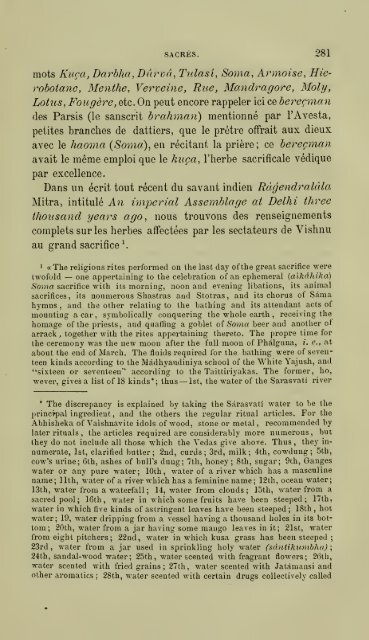La mythologie des plantes - Centrostudirpinia.It
La mythologie des plantes - Centrostudirpinia.It
La mythologie des plantes - Centrostudirpinia.It
Create successful ePaper yourself
Turn your PDF publications into a flip-book with our unique Google optimized e-Paper software.
SACRÉS. 281<br />
mots Kuça, Darbha,DûrDâ, Tidasi, Soma, Armoise, Hierobotane.<br />
Menthe, Verveine, Rue, Mandragore, Moly,<br />
Lotus, Fougère, etc. On peut encore rappeler ici ce bereçman<br />
<strong>des</strong> Parsis (le sanscrit brahman) mentionné par l'Avesta,<br />
petites branches de dattiers, que le prêtre offrait aux dieux<br />
avec le haoma (Soma), en récitant la prière; ce bereçman<br />
avait le même emploi que le kuça, l'herbe sacrificale védique<br />
par excellence.<br />
Dans un écrit tout récent du savant indien Ràgendralâla<br />
Mitra, intitulé An impérial Assemblage at Delhi three<br />
thousand years ago, nous trouvons <strong>des</strong> renseignements<br />
complets sur les herbes affectées par les sectateurs de Vishnu<br />
au grand sacrifice \<br />
' « The religious rites perfoi-med on the last day of tlie great sacrifice were<br />
twofold — one appertaiuing to the célébration of an ephemeral (aïkôhika)<br />
Soma sacrifice with its morning, noon and evening libations, its animal<br />
sacrifices, its nouraerous Shastras and Stotras, and its chorus of Sàma<br />
hymns , and the other relating to the bathing and its attendant acts of<br />
mounting a car , symbolically conquering the whole earth , receiving the<br />
homage of the pinests, and quaffing a goblet oî Sonia béer and another oi<br />
arrack, together with the rites appertainJng thereto. The propre time for<br />
the ceremony was the new moon after the fuU moon of Phâlguna, i. e., at<br />
about the end of March. The fluids required for the bathing were of seventeen<br />
kinds according to the Màdhyandiniya school of the White Yajush, and<br />
"sixteen or seventeen"' according to the Taittiriyakas. The former, ho,<br />
wever, gives a list of 18 kinds * ; thus — Ist, the water of the Sarasvati river<br />
' The disci-epaucy is esplained by taking the Sarasvati water to be the<br />
princi'pal ingrédient , and the othei's the regular ritual articles. For the<br />
Abhisheka of Vaishnavite idols of wood, stone or métal, recommended by<br />
later rituals , the articles required are considerably more numerous, but<br />
they do not include ail those which the Vedas give above. Thus , they innumerate,<br />
Ist, clarified butter; 2nd, curds ; 3rd, milk; 4th, cowdung ; 5th,<br />
cow's urine; 6th, ashes of bull's dung; 7th, honey ; 8th, sugar; 9th, Ganges<br />
water or any pure water; lOth, water of a river which has a masculine<br />
name; llth, water of a river which has a féminine name; 12th, océan water;<br />
13th, water from a waterfall ; 14, water from clouds ; 15th, water from a<br />
sacredpool; 16th, water in which some fruits hâve been steeped ; 17th,<br />
water in which five kinds of astringent leaves hâve been steeped; ISth , hot<br />
water; 19, water dripping from a vessel having a thousand holes in its bottom<br />
; 20th, water from a jar having some mango leaves in it; 21st, water<br />
from eight pitchers ; 22nd, water in which kusa grass has been steeped ;<br />
23rd , water from a jar used in sprinkling holy water (sdntihumbha) ;<br />
24th, sandal-wood water; 25th, water scented with fragraut flowers; 26th,<br />
water scented with fried grains; 27th, water scented with Jatàmansi and<br />
other aroraatics ; 28th, water scented with certain drugs coUectively called
















